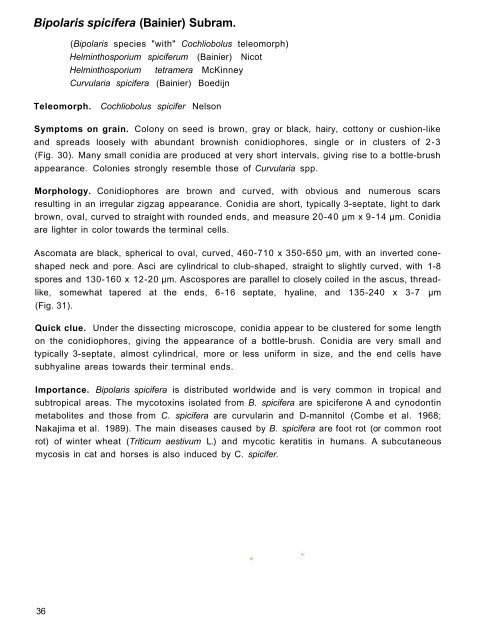A Pictorial Guide for the Identification of Mold ... - OAR@ICRISAT
A Pictorial Guide for the Identification of Mold ... - OAR@ICRISAT
A Pictorial Guide for the Identification of Mold ... - OAR@ICRISAT
You also want an ePaper? Increase the reach of your titles
YUMPU automatically turns print PDFs into web optimized ePapers that Google loves.
Bipolaris spicifera (Bainier) Subram.<br />
(Bipolaris species "with" Cochliobolus teleomorph)<br />
Helminthosporium spiciferum (Bainier) Nicot<br />
Helminthosporium tetramera McKinney<br />
Curvularia spicifera (Bainier) Boedijn<br />
Teleomorph. Cochliobolus spicifer Nelson<br />
Symptoms on grain. Colony on seed is brown, gray or black, hairy, cottony or cushion-like<br />
and spreads loosely with abundant brownish conidiophores, single or in clusters <strong>of</strong> 2-3<br />
(Fig. 30). Many small conidia are produced at very short intervals, giving rise to a bottle-brush<br />
appearance. Colonies strongly resemble those <strong>of</strong> Curvularia spp.<br />
Morphology. Conidiophores are brown and curved, with obvious and numerous scars<br />
resulting in an irregular zigzag appearance. Conidia are short, typically 3-septate, light to dark<br />
brown, oval, curved to straight with rounded ends, and measure 20-40 μm x 9-14 μm. Conidia<br />
are lighter in color towards <strong>the</strong> terminal cells.<br />
Ascomata are black, spherical to oval, curved, 460-710 x 350-650 μm, with an inverted cone-<br />
shaped neck and pore. Asci are cylindrical to club-shaped, straight to slightly curved, with 1-8<br />
spores and 130-160 x 12-20 μm. Ascospores are parallel to closely coiled in <strong>the</strong> ascus, thread-<br />
like, somewhat tapered at <strong>the</strong> ends, 6-16 septate, hyaline, and 135-240 x 3-7 μm<br />
(Fig. 31).<br />
Quick clue. Under <strong>the</strong> dissecting microscope, conidia appear to be clustered <strong>for</strong> some length<br />
on <strong>the</strong> conidiophores, giving <strong>the</strong> appearance <strong>of</strong> a bottle-brush. Conidia are very small and<br />
typically 3-septate, almost cylindrical, more or less uni<strong>for</strong>m in size, and <strong>the</strong> end cells have<br />
subhyaline areas towards <strong>the</strong>ir terminal ends.<br />
Importance. Bipolaris spicifera is distributed worldwide and is very common in tropical and<br />
subtropical areas. The mycotoxins isolated from B. spicifera are spiciferone A and cynodontin<br />
metabolites and those from C. spicifera are curvularin and D-mannitol (Combe et al. 1968;<br />
Nakajima et al. 1989). The main diseases caused by B. spicifera are foot rot (or common root<br />
rot) <strong>of</strong> winter wheat (Triticum aestivum L.) and mycotic keratitis in humans. A subcutaneous<br />
mycosis in cat and horses is also induced by C. spicifer.<br />
36
















